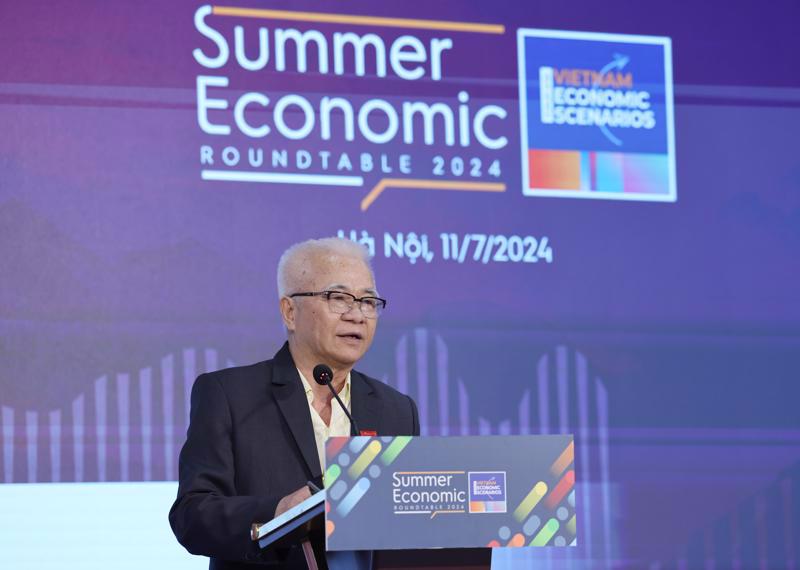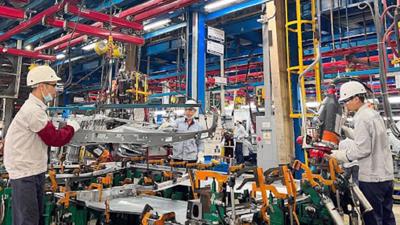To address “bottlenecks” hampering growth
The livestreamed Summer Economic Roundtable 2024, co-hosted by the Party Central Committee’s Economic Commission and Vneconomy / Vietnam Economic Times in Hanoi on July 11, heard recommendations from representatives of State management agencies and business associations as well as other stakeholders on addressing the “bottlenecks” hampering growth in the time ahead.

Vietnam’s economic situation in the second quarter and first half of 2024 was generally upbeat, setting the stage for growth to continue in the time ahead. Certain difficulties and challenges have, however, been forecast for the third quarter. The issues are especially relevant for an open economy like Vietnam’s, which is highly susceptible to global economic risks and uncertainties, and while it’s far from all doom and gloom, stakeholders believe that much will need to be done for the country to reach its 2024 growth target of 6-6.5 per cent.
Ms. Bui Thuy Hang, Deputy Director General of the Monetary Policy Department, State Bank of Vietnam
The government, the State Bank of Vietnam (SBV), and various ministries have recently implemented a raft of measures to help businesses overcome the challenges they face. In regard to borrowing costs, the SBV continues to employ monetary policy tools to ensure that lending rates come down, in line with government directives, despite the upwards global trend. We are consistently working to lower the lending rates credit institutions offer to customers.
In terms of exchange rate pressure, the global trend in the opening months of this year made the SBV’s management quite difficult. Nonetheless, it used various tools and measures, including selling foreign currency to intervene in the exchange rate, allowing for convenient foreign currency transactions by the public and businesses.
Furthermore, with the Law on Credit Institutions coming into effect on July 1, the SBV has issued a series of guiding circulars to simplify capital access for businesses and individuals. Moving forward, in addition to refining policy frameworks, we will hold meetings between banks and businesses so the former better understands the latter’s difficulties and can provide ongoing support.
Mr. Nguyen Van Dinh, Vice Chairman of the Vietnam Real Estate Association
Businesses in the real estate sector are facing major problems. Nationwide, over 1,000 real estate projects have stalled and are unable to proceed. Despite media reports suggesting an active market with rising prices, the reality is marked by paradox.
In the first half of this year, only 27,361 new real estate products were launched, representing about 15 per cent of 2018-2019 levels. Though this is actually an increase over recent periods, it remains small compared to what was previously considered “normal”. There were 22,399 transactions in the period, with a strong absorption rate of 80 per cent of supply. However, this is only about 20 per cent of 2018-2019 levels, indicating a significant 80 per cent fall in market demand.
With shrinking demand, how can businesses survive? The product structure reveals that most projects were approved a long time ago. Of these, land plots account for 46 per cent and affordable apartments 7 per cent, while social housing is quite scarce. The VND120 trillion (over $4.7 billion) support package has only disbursed about 1 per cent of its funds.
Despite significant price reductions, housing and real estate prices are still double those in 2018, despite the pandemic and economic difficulties. This is unreasonable.
The reasons are well-known, mainly stemming from regulatory barriers. We have seen many reforms and a strong commitment from the government and various ministries to accelerate institutional renewal and promptly implement laws to support businesses and localities. We fully agree with this approach.
However, we are concerned about the implementation process. If new decrees do not fully resolve the existing issues, bottlenecks will remain.
For example, will these new regulations apply to ongoing projects or only to new projects? We estimate that about 70 per cent of projects with severe issues involve land allocation, bidding, and auctions.
Businesses are also concerned about annual land payments creating difficulties. For instance, investment projects like resort villas or shophouses need a business cycle plan, but if they are subject to annual calculations, will investors be willing to participate? They will certainly hesitate at the very least.
We see that the government and ministries are being proactive and are committed to creating higher-quality institutions to address the issues. However, businesses remain concerned about how regulations will be implemented to thoroughly resolve the outstanding issues.
Ms. Doan Thi Thanh My, Head of the Land Department, Ministry of Natural Resources and Environment
Regarding land leases, the Vietnam Real Estate Association (VNREA) has expressed concern that annual land lease payments create instability and hinder business planning and operations. While I understand these challenges, I would like to highlight three key points.
Firstly, in recent times, we have seen concerted effort from government agencies and the National Assembly (NA) to finalize policy mechanisms.
Secondly, in terms of enforcement, these efforts have led to specific provisions outlining the responsibilities of ministries, local authorities, and affected parties under the law.
Thirdly, when we reviewed the implementation of the Land Law 2013, it was evident that business expectations need to be taken into account in enforcement. I want to clarify that the perception of annual lease payments causing instability for businesses may stem from how related agencies communicate. However, it is clear that the Party’s standpoint is to legally protect the rights of leaseholders, whether organizations or individuals. Lease agreements have fixed terms, and if businesses fulfill their financial obligations to the State, they are entitled to continue leasing. For current lessees, those who pay their leases annually are operating within the legal framework of land regulations, which safeguard their rights.
The Land Law 2024 specifies that land lease fees remain stable for five years and any adjustments will be tied to the CPI, ensuring that lease fees are not subject to annual fluctuations. This regulation is enshrined in the law, not in decrees, and the NA maintains a firm stance on this matter.
Mr. Vu Duc Giang, Chairman of the Vietnam Textile and Apparel Association
Vietnam’s textile and apparel exports surpassed $19.5 billion during the first half of 2024, marking a 4 per cent increase year-on-year. However, this growth primarily stemmed from the redirection of orders from other countries to Vietnam, with global consumption levels remaining stable.
New-generation free trade agreements have provided robust momentum for Vietnam to sustain its market presence globally. In 2023, its textile and apparel sector posted $40 billion in exports to 104 global markets. To maintain and expand this growth trajectory, the Vietnam Textile and Apparel Association has focused on diversifying markets and customer bases as well as broadening products and production capabilities.
Nevertheless, Vietnam’s textile and apparel industry faces significant challenges today. Firstly, there are varying import standards in every market, which continually introduce compliance complexities. Secondly, brand evaluation organizations impose divergent criteria, necessitating constant adaptation from our businesses to secure orders.
The third challenge revolves around global geopolitical dynamics.
The fourth challenge pertains to technological advancement and sustainability. Adapting to sustainable development trends is crucial for meeting market demands and maintaining stable order volumes.
The fifth challenge concerns labor issues. In the first half of this year, the industry witnessed workforce reductions of up to 6 per cent, with some areas experiencing even higher rates due to voluntary departures. Addressing these gaps requires significant training periods, ranging from six months to a year, for new hires to reach optimal productivity levels.
Regarding policy and strategic initiatives for the sector, the Prime Minister’s Decision No. 1643/QD-TTg in 2022 approved a comprehensive strategy for Vietnam’s textile and leather industry development to 2030, with a vision extending to 2035. Despite this, effective implementation remains a challenge. While the strategy is sound, the critical task lies in practical execution, local zoning plans for industrial development, and attracting investments into the dyeing sector to reduce reliance on imported raw materials.
In practice, many localities remain cautious about wastewater management issues, which impacts comprehensive planning efforts. Addressing these challenges necessitates a focused industry strategy that aligns with national directives to strategically develop industrial parks, including robust investments in the dyeing sector to foster domestic fabric production. Vietnam currently imports approximately $16 billion worth of fabric annually, predominantly sourced from China.
Mr. Vu Tu Thanh, Deputy Regional Managing Director and Vietnam Chief Representative, US-ASEAN Business Council
I recently met with the US State Department. The US has shown significant interest in helping Vietnam with the development of its electronics manufacturing capabilities, building upon the groundwork established by FDI enterprises. As part of the Comprehensive Strategic Partnership, there is an initiative known as the Delta Network, which aims to establish an electronics supply chain. The initiative is seeking to pilot its operations in Vietnam before expanding to other countries. However, it is unfortunate that Vietnam is unprepared due a lack of readiness.
Furthermore, some technology transfer consultants in the US have noted that their clients predominantly opt for China for technology transfer and manufacturing. Given the current circumstances, with the US tightening its technology policies towards China, companies are refraining from transferring technology there, though the demand persists and even grows. Therefore, they view Vietnam as a market of potential for technology transfer, particularly in electronics. However, Vietnam’s lack of readiness turns this opportunity into a challenge.
I believe Vietnam stands on the brink of producing strategic items in the electronics sector, for instance the light unmanned aerial vehicle industry, also known as near-range drones. Few countries worldwide, besides China, produce such items. The global market for near-range drones in 2023 exceeded $63 billion, with China commanding an 80 per cent share.
It is understood that, in the future, 80 per cent of this market won’t be exportable to the US or other countries that deem it sensitive and impose controls. This presents an opportunity for Vietnam. Vietnamese engineers and businesses are fully capable of designing and manufacturing such products. Some companies can do so independently of China’s supply chain, fully meeting US National Defense Authorization Act (NDAA) standards. Globally, aside from China, only the US, Israel, Russia, Turkey, and Iran possess such capabilities.
Another promising product is AI-integrated security cameras, which are well within the capabilities of Vietnamese enterprises. Vietnam has the potential to replace China in this field. These are all examples of the new growth opportunities we can seize.
Ms. Do Thi Thuy Huong, Executive Board Member, Vietnam Electronics Industries Association
Towards the end of 2023 and in the first five months of this year, Vietnam’s electronics sector encountered significant challenges due to the global consumer slowdown. As our main exports are consumer electronics, many enterprises have suffered from declining orders in traditional markets, leading some to cut their workforce by up to 70 per cent. This underscores the plight of Vietnamese firms within the supply chain; struggling with unstable orders and a disadvantaged position compared to larger FDI enterprises.
Another major hurdle for Vietnam’s electronics sector, particularly small and medium-sized enterprises (SMEs), is the scarcity of skilled workers, limited access to capital and financing, and the tendency to lag behind in technological advancement.
Vietnam is also grappling with an aging workforce, making recruitment increasingly difficult even for general workers. While we often discuss the importance of a high-quality workforce in our policy strategies, international experts emphasize the need for trained and skilled workers over abstract qualifications. Hence, our policies must be clear to avoid misinterpretation and ensure effective decision-making.
We therefore advocate support to help enterprises overcome challenges in training and skills development. It is crucial to leverage international assistance, particularly in semiconductor electronics, offering scholarships to students pursuing these demanding fields.
Vietnam’s strategy of cultivating a semiconductor workforce aims to train 50,000 professionals by 2030. With three decades of personal experience in this field, I question whether this target is overly ambitious. Given the time required, of upwards of five years to produce qualified semiconductor engineers, achieving this goal within six years seems challenging.
Furthermore, we must consider whether this large-scale initiative is truly necessary. Taiwan (China), a semiconductor leader, annually educates and sponsors only 25 semiconductor students from its top universities, which raises doubts about Vietnam’s capacity to meet such a target and the subsequent employment prospects for graduates.
Dr. José Viñals, Group Chairman of Standard Chartered PLC
Despite the intricate global landscape, I am optimistic about Vietnam’s economic performance this year compared to last. Vietnam achieved a growth rate of about 5 per cent last year. This year, we anticipate a growth rate exceeding 6 per cent in the latter half. Thus, Vietnam is poised to achieve a 6 per cent growth rate for the year as a whole.
A 6 per cent growth rate this year is quite promising, surpassing what most economies can achieve. Vietnam remains at the forefront of global growth, which is noteworthy. However, caution is warranted. Economic growth, like nurturing a tree, requires consistent support through effective policies to build a strong economic and financial foundation in an attractive investment environment, and to sustain competitiveness amid rising international competition.
Nevertheless, I am confident in Vietnam’s medium-term economic prospects, despite short-term uncertainties related to exchange rate fluctuations, recent inflation concerns, and certain political fluctuations. However, such challenges are common across economies. The key lies in maintaining growth prospects and implementing sound policies to propel Vietnam towards sustainable and environmentally-friendly economic development, which is crucial.
Globally, environmental, social, governance (ESG) considerations are increasingly vital for companies. Vietnam understands this well and has embraced ESG to promote a sustainable economy and continue attracting essential FDI.
In this context, we have partnered with the Vietnamese Government on various initiatives, including signing MoUs worth $8.5 million during COP26 in Glasgow in late 2021, witnessed by the Prime Minister. Recently, at COP28, Standard Chartered committed $3 billion through five MoUs to support sustainable development projects. In total, $11.5 billion has been committed and is currently in progress.
We are also collaborating extensively with the Vietnamese Government not only on environmental initiatives but also on developing carbon markets, carbon credit markets, and other crucial aspects of the ESG framework. Additionally, we are addressing social issues such as diversity, inclusion, community support, microfinance, and loans for small and medium-sized enterprises.
At Standard Chartered, we have allocated $17.6 billion in sustainable assets globally to finance environmental and social initiatives. Vietnam is an important partner in advancing these commitments to development.





![[Interactive]: Economic overview - October 2024](https://media.vneconomy.vn/400x225/images/upload/2024/11/07/6abc3c6d-d540-4fc8-ab91-9ef3dfe30e0e.png)

